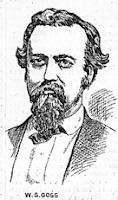 Of course, there were cases where decapitation was part of a deranged killer’s psychotic obsession. Joseph Lapage raped and murdered 17-year-old Josie Langmaid, who was on her way to school in Pembroke, New Hampshire in 1875. Then, for no apparent reason, Lapage cut off her head and carried it half a mile before dropping it in the woods.
Of course, there were cases where decapitation was part of a deranged killer’s psychotic obsession. Joseph Lapage raped and murdered 17-year-old Josie Langmaid, who was on her way to school in Pembroke, New Hampshire in 1875. Then, for no apparent reason, Lapage cut off her head and carried it half a mile before dropping it in the woods. More often, the head was removed to obscure the identity of the corpse. The killers of Pearl Bryan in Newport, Kentucky, in 1896, were accused of severing her head while she was still alive. Whether she was alive at the time or not, Pearl Bryan’s head was removed to hide her identity. The killers might have succeeded in this if they had thought to remove her shoes as well.
More often, the head was removed to obscure the identity of the corpse. The killers of Pearl Bryan in Newport, Kentucky, in 1896, were accused of severing her head while she was still alive. Whether she was alive at the time or not, Pearl Bryan’s head was removed to hide her identity. The killers might have succeeded in this if they had thought to remove her shoes as well.The most common reason for dismembering a corpse was to make it easier to hide. In 1873, William Udderzook had to cut the arms and legs from the body of Winfield Scott Goss because tree roots in the Pennsylvania woods where the murder was committed, made it impossible to dig a grave long enough. He should have been worried about depth as well; the shallow grave could not hide the body from circling buzzards.
 In 1849, Dr. John White Webster thought he could hide the body of Dr. George Parkman by cutting it into pieces and disposing of them in the privy of his Harvard laboratory. It proved to be less effective than he had anticipated.
In 1849, Dr. John White Webster thought he could hide the body of Dr. George Parkman by cutting it into pieces and disposing of them in the privy of his Harvard laboratory. It proved to be less effective than he had anticipated.The remains of Abijah Ellis were found inside of two barrels floating in Boston Harbor, in 1872—torso in one, head, arms, and legs in the other. It was never conclusively determined who put them there.
 After murdering William Druse in 1884, Roxalana Druse and her family tried to dispose of his body by removing the head and limbs, cutting the body into little pieces and burning them in the kitchen stove, then disposing of the ashes in the swamp near their Little Falls, New York home. But she could not hide the thick, acrid smoke from the neighbors and Roxalana Druse was arrested for her husband’s murder.
After murdering William Druse in 1884, Roxalana Druse and her family tried to dispose of his body by removing the head and limbs, cutting the body into little pieces and burning them in the kitchen stove, then disposing of the ashes in the swamp near their Little Falls, New York home. But she could not hide the thick, acrid smoke from the neighbors and Roxalana Druse was arrested for her husband’s murder. In 1896, Adolph Luetgert took body disposal to a new level by dissolving the corpse of his wife, Louise, in a vat of lye in his Chicago sausage factory. Though he successfully eliminated Louise’s body, it was not enough to save him from conviction for her murder.
In 1896, Adolph Luetgert took body disposal to a new level by dissolving the corpse of his wife, Louise, in a vat of lye in his Chicago sausage factory. Though he successfully eliminated Louise’s body, it was not enough to save him from conviction for her murder.


.png)






.jpg)











0 comments :
Post a Comment